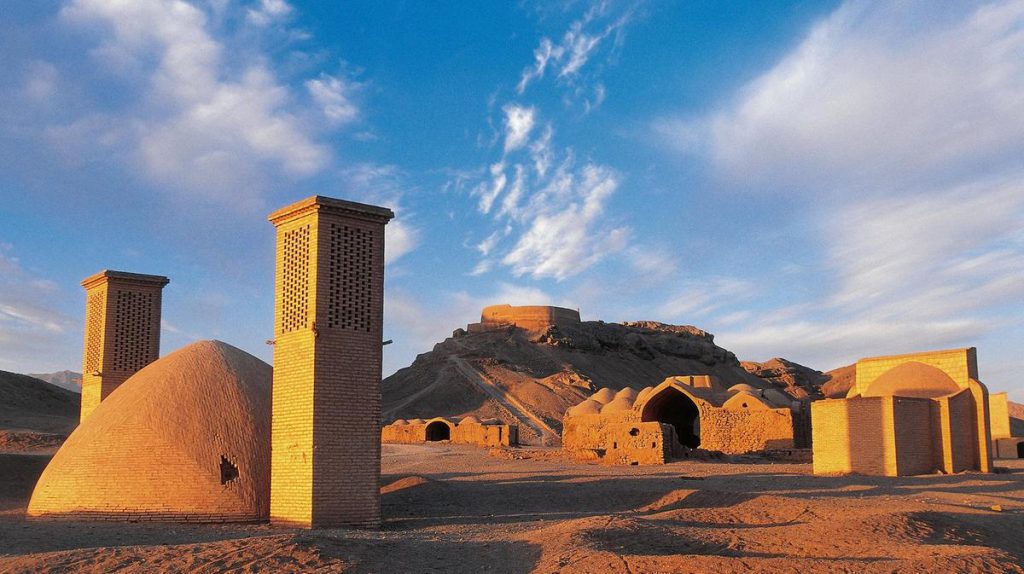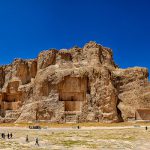
Zoroastrian Towers of Silence in Yazd (Dakhmeh Zartoshtian)
The spooky secrets of Persia’s ancient religion are expecting you in Zoroastrian Towers of Silence in Yazd (Dakhma or Dakhmeh-ye Zartoshtiyun)! What are towers of silence?! To say that they are hilltop cemeteries would be wrong. And to say that they are a kind of sky burial might make you even more confused. That’s why I’m going to tell you the whole story. To begin with, you should know that besides the peaceful fire temples and the grand moral enlightenment, Zoroastrianism, like any other religion, has its special beliefs and customs concerning the dead. Based on ancient tradition, Zoroastrians exposed the dead to the sun and scavenging birds. Why?! The beliefs, rituals, and architectural secrets behind it are actually pretty interesting. On this blog, besides discovering these secrets, you’ll find the charms of Yazd’s two towers.
Contents
- 1 Why Visit Yazd’s Towers of Silence
- 2 What are Towers of Silence Iran
- 3 Other Fascinating Stories Behind Zoroastrian towers of silence Iran
- 4 The Spooky Rituals
- 5 Structure of Yazd tower of silence
- 6 Yazd’s Towers of Silence Iran
- 7 The Indian Dakhma (Dakhmeh)
- 8 Golestan Dakhmeh
- 9 Other Zoroastrian Attractions in Yazd
- 10 More About Yazd’s Towers of Silence
- 11 Like to visit Yazd Towers of Silence?
- 12 Interested in Zoroastrian culture?
- 13 Zoroastrian towers of silence Tours
- 14 Dakhmeh Zartoshtian on Map

Zoroastrian priests pray to honor the dead inside a temple in Pune, India.
Why Visit Yazd’s Towers of Silence
- They are on of the country’s most fascinating Zoroastrian attractions
- They give you an introduction to the ancient religion
- The towers introduce you to the scary secrets of Zoroastrianism
- You’ll learn about the cultural exchange of Iran and India

Towers of Silence Iran photo
What are Towers of Silence Iran
Once upon a time in Iran, Zoroastrians built structures on high cliffs or mountains for their dead. The practice of leaving your beloved ones on top of a tower as food for scavenging birds may give you goosebumps. Yet the reasons behind this ritual make it less scary. One of the suggested reasons seems to have roots deep in Zoroastrian beliefs. One is that the 4 elements (water, fire, air and soil) are sacred and one must avoid impurifying them.
The other is that when soul exits the body, the devil can immediately possess it. This makes the body contaminated. So, burying the corpse or burning it with fire would be impurifying the sacred elements. Therefore, ancient Zoroastrians built structures at a high altitude, and left the flesh for the scavenging birds and the bones for decomposition. This form of sky burial was in use in Iran until it became illegal in early 1970s.

Zoroastrianism Tower of Silence Yazd
Other Fascinating Stories Behind Zoroastrian towers of silence Iran
The exact reason why Zoroastrians put the dead out in the open instead of burying them like Christians and Muslims, or burning them like Hindus is a subject of disagreement! Beside the one reason we mentioned earlier, some other findings suggest that the towers had nothing to do with Zoroastrian beliefs and that they were originally built for hygienic purposes at the time of pandemics (like the Plague) or wars with high casualties. Some historians even believe that the ritual originates from the Aryan inhabitants who moved to Iran from cold Siberian mountains, or from the Magi, the mysterious priests of ancient Persia!

Zoroastrianism Towers of Silence Yazd
The Spooky Rituals
Immediately after somebody’s death, Zoroastrians performed a collection of ceremonies, rituals and prayers to save his/her soul. Symbolizing the spiritual unity of the dead with God, the performers kept a fire burning and held hands at every step of the rituals. They washed the body and wrapped it in white cotton clothes and carried it to the tower. Then the person responsible for the dead, performed some other rituals and carried it to the top of the tower. The place where he put the bodies was not random. In the outermost circle, he put men, in the central circle, the women, and in the innermost circle, the children. After fixing the corpse on top of the tower, he left the bodies there for a period of time (sometimes even a year). After that, he threw the bones into a pit (called Estodan) in the middle of the tower.

Structure of Yazd tower of silence
The architecture of towers of silence grew more complex over time. But probably to keep contamination and disease away from themselves, Zoroastrians always built their Dakhma away from the cities. They usually built them on top of a natural platform like a hilltop. The cylinder-shaped towers were almost flat on the top and had a slight slope down to the center. A short wall also surrounded the circular roof. If the tower had an entrance, it was closed with a stone or metal door. Yet most of them lacked such a portal and may only have been accessible by a ladder. Yazd, as Iran’s center of Zoroastrianism, showcases two of such creepy yet captivating relics.

Yazd’s Towers of Silence Iran
After the fall of Sassanid Empire with the Muslim Conquest of Persia, Zoroastrians started migrating to Yazd. They gradually made the city a Zoroastrian center that featured temples and towers of silence. Two of such towers, one from Qajar era and the other much older, can be found in the southeastern outskirts of Yazd. Other structures were also built near the towers for ceremonial purposes. Since the towers were originally built out in the desert, away from the city, they have stayed unaffected by the destruction caused by wars. Until around 1971, the towers were still in use and corpses could still be found on top of the towers. Like to know more about these two towers? Here they are:

The Indian Dakhma (Dakhmeh)
The tower on the right, known as Mankeji Hutria Dakhma, was built as part of the support the Zoroastrian Society of India had been directing toward the Zoroastrian society of Iran. Their agent, Mankeji Sahib, did his best in Iran to help relieve the pressures Zoroastrians tolerated as a minority group. His efforts made him one of the most influential people in the community. Beside leaving them this tower of silence, he helped build schools, pay for students’ education and abolish Zoroastrians’ taxes. The tower he helped build has a 15-meter diameter and is made of raw bricks and clay.

Golestan Dakhmeh
Since bringing the dead to Mankeji Hutria Dakhma was difficult, Golestan Dakhma was later constructed next to it. With a 25-meter diameter and a wall that extends 6 meters higher than the top of the hill on which it is located, the newer Dakhma is 150 meters to the west of the older Dakhma.

Other Zoroastrian Attractions in Yazd
The Fire Temple of Yazd and the Museum of Zoroastrian History and Culture are two other Zoroastrian magnets in the city.

More About Yazd’s Towers of Silence
Where are Yazd’s Towers of Silence
The towers are located on the southeastern outskirts of Yazd, 10 kilometers from the city center and away from the other attractions.
Where to Eat near Yazd’s Towers of Silence
Karen Retro Restaurant
Caesar Restaurant
Ariana Restaurant
Like to visit Yazd Towers of Silence?
Then join our Discovering Zoroastrianism tour or one of our multi-day Cultural Tours.
Interested in Zoroastrian culture?
You can book a place on our few-hour Zoroastrian Ceremonies or Cooking Class with Zoroastrians tour.
Dakhmeh Zartoshtian on Map
Keywords: Zoroastrian sky burial, silence tower, sky burial Zoroastrian, Zoroastrianism sky burial, Persian tower of silence, Zoroastrian death rituals














I’ve been looking for this info. Thank you. The website style is also perfect.
Good job, cheers
Simple but amazing… With a deep philosophy. I really like to visit one someday! Thanks for sharing this.
Interesting place! Keep up the good job.
This is my first time pay a visit at this place.
Hell!
Yeah, even writing about it gave me goosebumps! 😀